
Saturday, November 16, 2024


Saturday, November 16, 2024

Welcome to the Schwartz Center for Performing Arts.
Please turn off all electronic devices. Photography, recording, or digital capture of this concert is not permitted.
404.727.5050 | schwartz.emory.edu | boxoffice@emory.edu
Audience Information
The Schwartz Center welcomes a volunteer usher corps of about 40 members each year. Visit schwartz.emory.edu/volunteer or call 404.727.6640 for ushering opportunities.
The Schwartz Center is committed to providing performances and facilities accessible to all. Please direct accommodation requests to the Schwartz Center Box Office at 404.727.5050, or by email at boxoffice@emory.edu.
The Schwartz Center wishes to gratefully acknowledge the generous ongoing support of Donna and Marvin Schwartz.
This concert is presented by the Schwartz Center for Performing Arts and is made possible by a generous gift from the late Flora Glenn Candler, a friend and patron of music at Emory University.


Rhiannon Giddens, voice, banjo, fiddle
Balla Kouyaté, balafon
Edward Pérez, bass
Francesco Turrisi, frame drums, accordion
Kaoru Watanabe, Japanese flutes, Japanese percussion
Layale Chaker, violin
Maeve Gilchrist, Celtic harp
Mario Gotoh, violin, viola
Mike Block, cello
Pura Fé, voice, lap-steel guitar
Sandeep Das, tabla
Shane Shanahan, percussion
Yazhi Guo, suona, Chinese percussion
Saturday, November 16, 2024, 8:00 p.m.
Emerson Concert Hall
Schwartz Center for Performing Arts
Please see the included insert for the concert program order. Program notes written by the Silkroad artists.
To find my way into composing for Silkroad, I began by learning some of the history of the transcontinental railroad. Despite the incredible engineering and nation-building achievement the railroad represented, the suffering and abuse of the laborers is a crucial part of the story. Many other historic events have this kind of dual narrative: inspiration on one hand, exploitation on the other. And yet, the most significant issues facing us today—regional wars, climate change—can only be solved through cooperation, by including everyone in the solution. A resolution that works for the powerful also has to work for those most affected by it.
“A Win For You” is a study on that idea. It’s a song about achievement through cooperation (“A victory for me doesn’t come at your cost… a win for me doesn’t mean that you lost”) with verses, a bridge, and a chorus. In between these sections are instrumental interludes, meditations which also showcase some of the glorious sonorities possible through this wonderful array of Silkroad musicians and cultures.
The piece is hopeful, optimistic, and very rhythmic. The final section is a “game” of rhythmic diminution: with every repeat of the chorus, one eighth note is removed from the time signature, which creates a sense of the music getting faster without actually speeding up. This is meant to evoke the feeling one gets as an epic project nears completion. But also it is a fun challenge for the performers, especially the percussionists.
Bani is a traditional piece from Mali with a title that literally means “Refusal.” Referencing the transatlantic slave trade, its message revolves around saying “NO” in order to make the world a better place, and asks both African nations and European nations, as well as their children, to join together in this message of unity.
Francis O’Neill was an Irish-born member of the Chicago Police Force who rose to Superintendent between 1873 and 1905. Chief O’Neill had substantial influence on the evolution of Irish music in the twentieth
century due to his collection of Irish folk tunes and songs. Among his many published works is O’Neill’s Music of Ireland, a collection of over 1,850 pieces of music. An Irish immigrant living in the United States during the peak wave of migration, O’Neill was employed by the relatively new and deeply disorganized concept of a police force, while also living a life deeply connected to the music of his homeland. His collection of tunes seemed a natural place to find a seed from which this composition grew. I was drawn towards a jig called “The Far Down Farmer.” During my research into the Irish involvement in the building of the American Transcontinental Railroad, I read about the tension that existed on occasion between Catholic and Protestant workers. The Catholic workers, often from a more economically depressed background, were sometimes referred to as Far Downers. I took this simple, two-part jig, and deconstructed the vocabulary, using the motifs and intervals as if I were building a train, laying the tracks and allowing the melody to build up momentum and speed as it gets slung between our respective instruments. I hope that this composition pays tribute to the roots of the tune and the back-breaking work of the workers on both sides of the religious and cultural divide, while allowing the melody to fly in the hands of women who would likely never have been given a fiddle or a flute, let alone a hammer to build with!
The sky is clear. A woman sings about her lover. She is intoxicated by the images she paints of him. He is on a train, flying away from her. Still she serenades, with her voice she weaves a tapestry of him, and falls in love with it. She walks along the train tracks, singing of her love. Her ambition is slowly winding like the tracks. It winds so slowly that she can’t see that it is changing direction. And as it changes direction, she begins to doubt. When she sings, she is not alone. She is joined by the generations of wanderers, who wound and wove their hopes in song. They cannot ride the train, although it was built on their backs. So they walk along the train track with her.
I wrote “Mahk Jchi” for Ulali to sing for Robbie Robertson’s Red Road Ensemble album in 1995. The word “Mahk Jchi” means “Our Hearts” in the Tutelo/Occaneechi/Saponi dialect of eastern North Carolina and Virginia. The words translated by Lawrence Dunmore say: Our Hearts are full, our minds are good, our Ancestors come and give us strength. They say never forget who you are or where you come from.
But, for this version of “Mahk Jchi,” I connect with a song I wrote when I was 16 years old called “Roots.” These two songs are similar in melody and fit together. I wrote “Roots” after learning about the devastation from the uranium strip mining in the Navajo Dene Four Corners, Canyons area. In these transitional times and amid great violence on people and earth, we pray that humanity can sway the authorities to move to a better, more sustainable way of life.
Yazhi Guo
“Pink Butterflies Picking Flowers” is a traditional piece of Chaozhou folk music from the regions of Guangzhou, Chaozhou, and Shantou in southern China. It has also gained popularity among Chinese immigrants in Southeast Asia. The composition is lively, characterized by a vibrant, playful melody that captures the imagery of a butterfly fluttering among flowers, collecting pollen, and evoking a sense of lighthearted joy.
The Chaozhou people, originating from Fujian and Guangdong, represent a distinct group within China’s rich history. They were among the first Chinese immigrants to venture abroad, known for their hard work and resilience—much like bees and butterflies that spread their wings across the globe.
At the heart of the piece is the suona, a traditional folk instrument from Chaozhou. With its slender body and small horn, the suona produces a delicate sound, enhanced by a reed crafted from wheat straw.
Tonight’s performance of “Pink Butterflies Picking Flowers” holds special significance as we pay tribute to the Chinese laborers who played a vital role in the construction of the American railroads.
This piece was originally brought by our pipa player Wu Man. Based on a folk tune popular in Guangdong in southern China, the piece tells a historical story of the Chinese railroad workers, with a slow and soulful melody expressing how the wives and mothers miss their husbands and sons who were building the railroad on the other side of the Pacific Ocean.
As Wu Man explains, “The Chinese pipa originated in Central Asia, and the American banjo came from Africa, both descended from traditional instruments that belong to the plucked strings family. I like the deep powerful sound of the banjo, combined with the gentle and rich character of the pipa. The dialogue between the two instruments brings an artistic charm that is both similar and unique. Of course, the vocal part represents the wife, mother, the storyteller. The magical female voice has
always been in my mind when composing, I know that Ms. Rhiannon Giddens’s voice will bring strong artistic appeal and imagination to the audience.”
English Lyrics:
Chinese Lyrics: Rainy day, Rainy day oh
落水天喽 落水天喽 the rain falls on my side
落水落到 without raincoat nor a hat on
我身边喽 drenched in rain oh
湿了衣裳 又无伞喽 so pitiful
“Rela”
光着头来 真可怜喽
Sandeep Das
Rela is an homage to the railroad workers of the Indian subcontinent who toiled to develop the country’s massive network of railways in the 19th and 20th century during the British Raj (the era in which India was under British colonial rule). Many parallels can be drawn between the American Transcontinental Railroad and the British development of railroads in India, with both undeniably marked by a complex web of history, modernization, and exploitation in the name of industrial progress.
This piece was inspired by chants attributed to the railroad workers of that era and incorporates a traditional Tabla rela, which is a type of improvisatory composition renowned for its high speeds, virtuosity, and cascades of complex notes and rhythms. The Hindi term rela comes from the word “rail” or “train,” and it is believed that modern Tabla relas were created to mimic the sounds of the first Indian railways.
“Rela” begins by evoking the sound of railroad crossings through a layer of complex rhythms on metallic instruments such as the triangle, gradually unveiling the sounds of deeper drums as the “train” embarks. Primarily a percussion ensemble piece, it is accompanied by a nagma (a looping melody that traditionally accompanies percussion performances in North Indian Classical music) composed in Raga Bhairavi, and features a variety of Indian percussion instruments such as the tabla (a set of two hand drums from North India), morshung (a South Indian metal percussion instrument played with the mouth, also called a “jaw harp” or “mouth harp”), and kanjira (a small frame drum prevalent in South Indian music), and incorporates instruments like the piano accordion, marimba, and Japanese taiko drums. The piece concludes with an exciting tukda (genre of fixed tabla composition) that dances between multiple instruments in a fiery finale.
“Rust and Dreams” Layale
Chaker
This piece was inspired by my visit last winter to an abandoned train station in Baalbeck, a city in the Bekaa Valley of Lebanon. Custom-designed to navigate the steep slopes between Beirut, Damascus, and Jerusalem, the railroad linking Lebanon, Palestine, and Syria was a world-class engineering feat of the late ninteenth century. Baalbeck, with its ancient history as a crossroads of civilizations, once represented connection and exchange. The train station, the last stop in Lebanon, was a gateway to the wider world, reflecting the unity of a region that, before colonial rule, was one vast, interconnected land.
This work reflects on that interconnectedness—a region once seamless, now fractured by borders imposed after colonialism, some of which have become impossible to cross. It explores the lost fluidity and exchange between places and peoples, symbolized by the disused railways. Yet beyond mourning the disconnection, it seeks to uncover the enduring desire to reconnect what has been severed—culturally, historically, and physically. The piece meditates on the possibilities of healing these divisions and reimagining a future where shared pathways overcome the boundaries of greed, conquest, and colonial rule.
“Summit” Shane
Shanahan
Shanahan’s composition originated at a Train Station Trio residency at the California State Railroad Museum in Sacramento. It was inspired by the workers who were left out of the famous photo celebrating the driving of the Golden Spike, which completed the Transcontinental Railroad at Promontory Summit, Utah. The western portion of the railroad was built mainly by Chinese immigrants who weathered extremely harsh conditions, accomplishing feats of incredible human strength and persistence. Despite their Herculean efforts, the Chinese were not included in the iconic photo of the railroad’s completion, their essential contributions were not acknowledged, they were denied citizenship and, in some cases, were deported back to China.
“Summit” seeks to highlight this lesser-known chapter of American history while musically navigating the landscapes of the Sierra Nevada Mountains, where these workers endured significant sacrifices against the backdrop of the region’s remarkable natural beauty.
“Swannanoa Tunnel” / “Great Grandpa’s Banjo” Traditional Arranged by Pura Fé
I named “Great Grandpa’s Banjo” for my grandmother’s grandfather Boyette Lee who played the banjo during slavery. He and his brothers played at every function in the county. Their father was a plantation owner who grew up and inherited his father’s plantation and slaves. One of the slaves he grew up with, Sarah Lee, was the love of his life and together they had four sons. The oldest son was Boyette Lee who inherited his father’s land after slavery was abolished. Boyette married Easter Blackwell who came from the nearby Indian community. She came from many generations of women singers. Easter and Boyette had seven daughters who sang. Everybody made music. This song is in memory of them. The words imitate the banjo in this old–timey Indian woman’s shuffle beat that is danced. I feel my ancestors in my feet and in my heart. They carry me through music.
“Swannanoa Strings” Traditional Arranged by Silkroad Ensemble
“Swannanoa Tunnel” / “Steel-Driving Man” Traditional Arranged by Rhiannon Giddens
“Swannanoa Tunnel” or “O Babe” originated from the black laborers who built the tunnel before crossing over into white culture. The black voices that created the song were soon forgotten, which has happened quite often within the African American experience. “Swannanoa Tunnel” is my tribute to the ghosts of the hard working men who gave their lives, yet whose stories have been forgotten and words claimed not as their own; a reminder of where this music truly comes from. “Steel Driving Man” is a version of the popular traditional tune “John Henry,” the well known folk hero who beat the steam drill with his hammer, only to die of a burst heart in the end. The version I play is from my mentor Joe Thompson, black traditional fiddler from my part of North Carolina.
Much thanks to the incredible scholarship of Kevin Kehrberg and Jeffrey A. Keith, who painstakingly uncovered this story. Learn more at: bittersoutherner.com/2020/somebody-died-babe-a-musical-coverup-of-racismviolence-and-greed.
“Tamping Song” Haruka Fujii
While doing research for our project American Railroad, I was surprised to discover that after the Chinese Exclusion Act of 1882, Japanese immigrants became one of the dominant workforces. By 1906, more than 13,000 Japanese immigrants were working for the railroads. Later, under pressure, Japan would stop labor immigration to the United States via the Gentleman’s Agreement of 1908. During this research I also discovered a recording of the “Tamping Song”—a railroad worker’s song released on Columbia Records Japan in 1963. Using an inspirational melody from this song, my work weaves the ambition, dreams, and hopes of the immigrant workers on the front lines of the railroad construction in the United States with the sentiment for their homeland.
The video that runs during this performance was designed by visual artist Camilla Tassi. In it you will see a collection of real historical photos from the cultures and communities the show explores. For Pura Fé’s pieces in particular, Pura Fé contributed personal family photos aimed at reminding audiences of Native peoples’ important continued cultural presence in America. Refer to the end of this program for image citations.
Yo-Yo Ma conceived Silkroad in 1998, recognizing the historical Silk Road as a model for radical cultural collaboration—for the exchange of ideas, tradition, and innovation across borders. In an innovative experiment, he brought together musicians from the lands of the Silk Road to co-create a musical language founded in difference, thus creating the foundation of Silkroad: both a touring ensemble comprised of world-class musicians from all over the globe and an organization working to make a positive impact across borders through the arts. Today, under the leadership of Artistic Director Rhiannon Giddens, Silkroad leads initiatives and educational programming alongside the creation of new music by the Grammy Award–winning Silkroad Ensemble. For more information, please visit Silkroad.org.
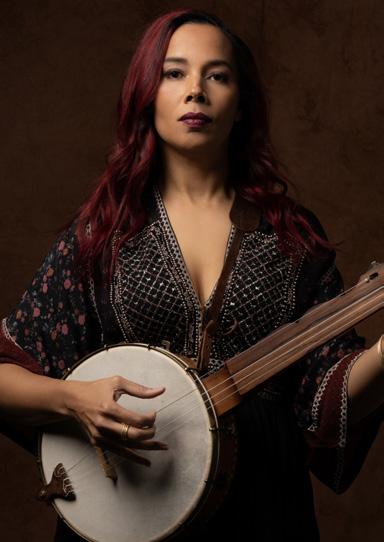
Giddens, Voice, Banjo, Fiddle
Rhiannon Giddens has made a singular, iconic career out of stretching her brand of folk music, with its miles-deep historical roots and contemporary sensibilities, into just about every field imaginable. A tw0-time Grammy Award and Pulitzer Prize–winning singer and instrumentalist, MacArthur “Genius” grant recipient, and composer of opera, ballet, and film, Giddens has centered her work around the mission of lifting people whose contributions to American musical history have previously been overlooked or erased, and advocating for a more accurate understanding of the country’s musical origins through art.
As Pitchfork once said, “Few artists are so fearless and so ravenous in their exploration”—a journey that has led to NPR naming her one of its 25 Most Influential Women Musicians of the 21st century and to American Songwriter calling her “one of the most important musical minds currently walking the planet.”
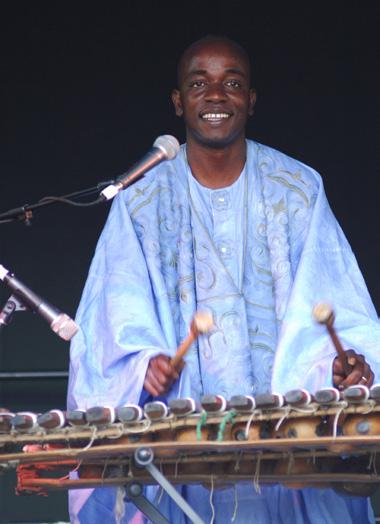
To say that Balla Kouyaté was born into a musical family is an understatement. His family lineage goes back over 800 years to Balla Faséké, the first of an unbroken line of djelis in the Kouyaté clan. Djelis are the oral historians, musicians, and performers who keep alive and celebrate the history of the Mandé people of Mali, Guinea, and other West African countries. Kouyaté explains that the word “Djeli” derives from his Mandinka language, “It means blood and speaks to the central role we play in our society.” One must be born into it. The Kouyaté family is regarded as the original praise-singers of the Malinké people, one of the ethnic groups found across much of West Africa. In 2001, the “Sosso bala” was declared a site of intangible cultural heritage by UNESCO. This powerful symbol of Mande culture is brought out once a year for ceremonial playing. Kouyate regularly plays with world renowned West African musicians touring in the States. He accompanies kora master Mamadou Diabaté, and in 2004 joined NEA National Heritage Fellow Sidiki Cond Kouyaté for a month-long residency at Carnegie Hall.
In 2010, Kouyaté was awarded a Mass Cultural Council Fellowship in the Traditional Arts. In 2014, he and his son Sekou were awarded a Mass Cultural Council Traditional Arts Apprenticeship, helping to ensure the continuance of this hereditary art. Kouyaté’s dedication to carrying on his family’s hereditary role as a Djeli, his musical virtuosity, and his humility truly set him apart from others. He is an exemplar of the kind of traditional artist the National Heritage Fellowships were established to recognize.

Edward Pérez, Bass
Bassist, composer, and Grammy Award–nominated bandleader Edward Pérez resides in the cultural crossroads of Queens, New York, where he maintains musical collaborations in a myriad of styles. The early years of Pérez’s career included stints in Boston and Lima, Peru, where he began his formation in jazz, Latin jazz, and Afro-Peruvian styles. Since arriving in New York in 2005, Pérez has toured throughout the world, performing in more than twenty countries for acclaimed bandleaders in jazz such as Paquito D’Rivera, Ralph Peterson Jr, Afro-Latin Jazz Orchestra, and Ignacio Berroa, and even sharing the stage with jazz luminaries such as Lee Konitz, Kenny Werner, Lionel Loueke, Mark Turner, and Seamus Blake. His own project, Terraza Big Band, received a Grammy nomination in the large ensemble category for their debut recording “One Day Wonder,” featuring compositions by Pérez as well as co-leader Michael Thomas. Pérez’s numerous recording credits as a sideman include three Latin Grammy Award–nominated recordings, as well as another Grammy nod in the Latin jazz category.
Pérez’s wide-ranging musical curiosity has led him to explore a myriad of styles, performing with renowned artists such as Lebanese oud master Marcel Khalife, flamenco phenom Diego Amador, Colombian singer Lucia Pulido, and Galician gaita powerhouse Cristina Pato. Owing to the lasting influence of his years in Lima, he has performed with many of the greats of Afro-Peruvian music, including Oscar Avilés, Julio “Chocolate” Algendones, Juan Medrano Cotito, and Grammy Award winner Eva Ayllón. Pérez currently maintains his own project in the Afro-Peruvian genre, Festejation, a band which tours throughout the northeastern United States. Currently a member of Silkroad, Pérez regularly collaborates with other members of the collective and has even shared the stage with its
founder, Yo-Yo Ma, performing Pérez’s own compositions in David Geffen Hall at Lincoln Center. Just as Pérez’s performance career is not limited to jazz, his compositions and arrangements in a wide variety of styles have been performed in venues such as the Kennedy Center, Massey Hall, Chicago Symphony Center, El Gran Teatro Nacional de Lima, Damascus Opera House, and Boston Symphony Hall.
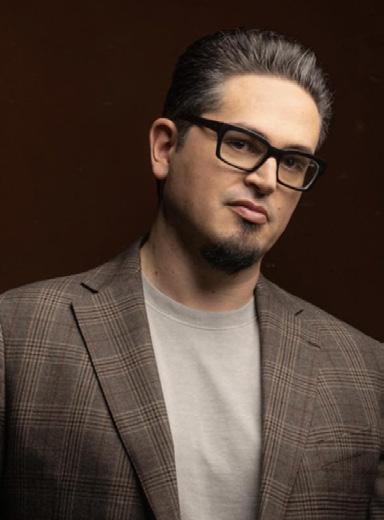
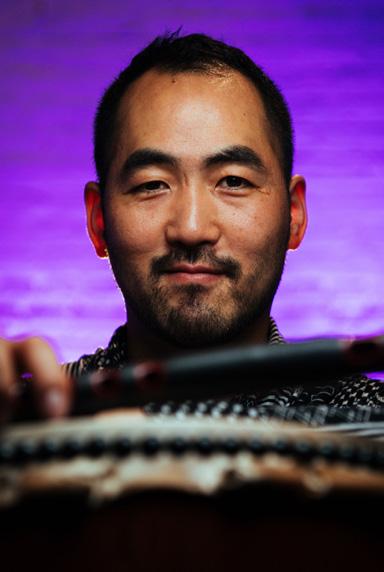
Francesco Turrisi has been defined as a “musical alchemist” and a “musical polyglot.” He has released five critically acclaimed albums as a leader and two as co-leader (Tarab, a cross boundary innovative ensemble that blends Irish and Mediterranean traditional music, and Zahr, a project that looks at connections between southern Italian traditional music and Arabic music).
Acclaimed composer and instrumentalist Kaoru Watanabe’s melodic, authentic, and engaging music focuses on points of connection: the joints between Western jazz and Japanese theater, folk traditions and political action, the ancient and the all-too-contemporary. Born into a musical family, Watanabe began his training at a young age, eventually graduating from the Manhattan School of Music, then devoting a decade overseas performing with and ultimately leading the world-renowned Taiko drum performance group Kodo. His ten years in Japan profoundly influenced Watanabe’s practice. His signature skill of infusing Japanese culture to disparate styles has made him a much–in–demand collaborator, having worked with Wes Anderson, Yo-Yo Ma, Mikhail Baryshnikov, Laurie Anderson, Jason and Alicia Hall Moran, Bando Tamasaburo, Eva Yerbabuena, and Zakir Hussain, among many others. Whether writing for solo performances, interdisciplinary ensembles, film, or symphony orchestras, he regularly explores social justice, history, and heritage issues.
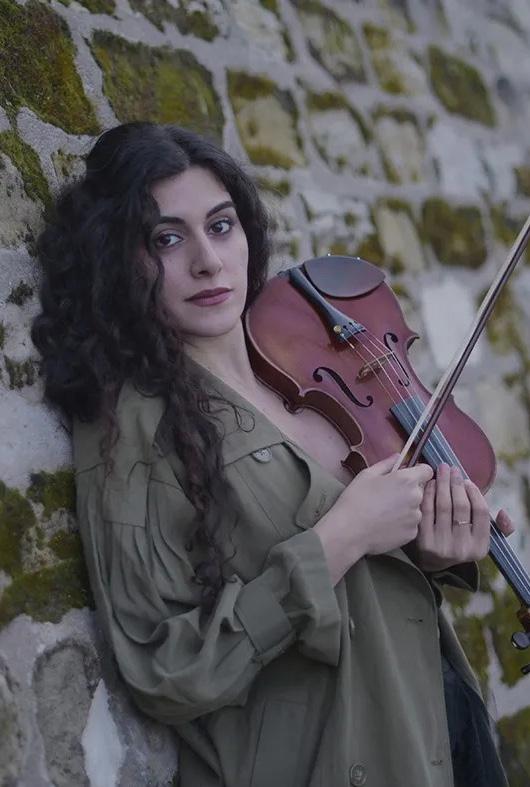
Photo by Anna Rakhvalova
Raised on the verge of several musical streams since childhood, Lebanese violinist and composer Layale Chaker debuted her musical training at the National Higher Conservatory of Beirut in her native Lebanon. She later pursued her music at Conservatoire de Paris and the Royal Academy of Music in London, and is working towards her doctoral degree at Ecole des Hautes Etudes in Paris. She has studied under professors such as Mohamed Hashem, Carmen Scripcariu,
Jeanne-Marie Conquer, and Nicholas Miller. Chaker has appeared as a soloist, performer, improviser, and composer in concerts, recitals, and projects around Europe, the Middle East, North and South America, and Asia, with collaborations and commissions with Oxford Orchestra, West-Eastern Divan Orchestra, Holland Baroque, Babylon Orchestra, Avignon Festival, Lucerne Festival, National Sawdust, London Jazz Festival, Wigmore Hall, and New World Symphony, among others.
She is also the founder and leader of Sarafand, with whom she has released the album Inner Rhyme that received features in the New York Times, The Strad, Songlines as Top of The World in March 2019 with a fivestar review, NPR’s number two of 10 Best Releases of January 2019, and was number one for weeks on the World Charts of iTunes and Amazon Music. Chaker is a Ruth Anderson 2017 Competition Prize winner, the recipient of the Royal Academy of Music’s 2018 Guinness Award and the Nadia and Lili Boulanger 2019 Scheme, and a finalist of the Rolex Mentor and Protégé 2018 Prize.
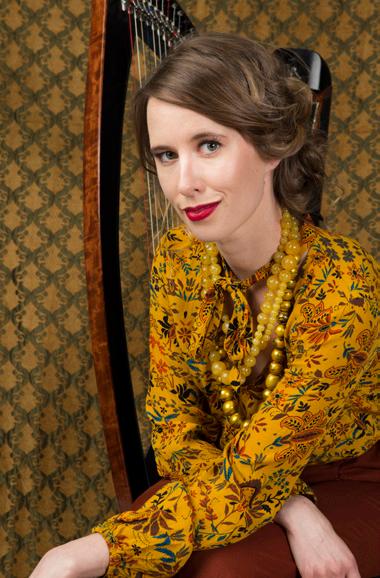
Edinburgh–born harpist and composer Maeve Gilchrist has been credited as an innovator on her native instrument and taken the Celtic (lever) harp to new levels of performance and visibility. Currently based in Kingston, NY, Gilchrist tours internationally as a solo artist and composer, as well as being a member of the Grammy–nominated Silkroad Ensemble, Arooj Aftab’s Grammy Award–winning Vulture Prince Ensemble, and as part of the multi-disciplinary quartet Edges of Light. She has performed and recorded with such luminaries as Yo-Yo Ma, Frankie Gavin, esperanza spalding, Bruce Molsky, Ambrose Akinmusire, and Solas. As a composer,
Gilchrist straddles the worlds of folk and classical with pieces including her original concerto for symphony orchestra and harp (a co-commission with Luke Benton), a three-movement Samuel Beckett–inspired piece for harp, string quartet, and sound samples which was premiered at the Edinburgh International Harp Festival in the spring of 2018, and a number of other pieces for harp ensembles and strings. She is a regular visiting artist at the Berklee College of Music and has had a number of instructional books published by Hal Leonard and 80 Days Publishing. Gilchrist has released a number of albums to her name on the Adventure Music Record Label, as well as being a featured soloist on the Dreamworks blockbuster movie soundtrack How To Tame Your Dragon: The Hidden World. Her most recent album, The Harpweaver, has garnered international acclaim including a five-star review from the Irish Times, who described it as “buoyant, sprightly and utterly beguiling . . . a snapshot of a musician at the top of her game.”
Gilchrist is the co-music director of the WGBH holiday show, a Christmas Celtic Sojourn, and the co-artistic director of the brand new Rockport Celtic Festival, an innovative new festival focused on crosscuration and the outer-fringes of Celtic music.

Mario Gotoh, Violin, Viola “Stunning, magical, unique …” —Time Out NY
“I’ll be thinking about my one-to-one concert with Mario Gotoh for a long time to come.”
NPR: All Things Considered
Born in Japan, based in New York City, Dr. Mario Gotoh is a Grammy Award winner who has distinguished herself in multiple roles as an innovative, creative violinist, violist, passionate educator, and composer with a remarkably unique style in all genres, performing worldwide. An avid interdisciplinary collaborator, Gotoh is a featured actor in William Kentridge’s The Head and The Load. She regularly records and performs on soundtracks and with pop artists including Stevie Wonder, Brian Wilson, Roger Waters, Sting, Katy Perry, and Doja Cat, and broadcasts such as the Grammy Awards, SNL, MTV VMAs, Colbert, and Letterman. She was the original violinist-violist for Broadway’s Hamilton: An American Musical. She holds dual degree doctorates and masters of both violin and viola performance. Gotoh is inspired by her community activism, language, literature, cooking, writing, visual arts, film, swimming, and exploring cultures worldwide.

Mike Block is a pioneering cello player, singer, composer, and educator, passionate about cross-cultural collaboration through music. Acclaimed by the New York Times for his “vital rich-hued solo playing,” and by Salt Lake City Desert News as “a true artist . . . a sight to behold,” Block “is one of the bravest, most intriguing musicians on the American fusion scene” (Gramophone). Block’s performances offer a rich mixture of classical repertoire, folk music, original compositions, and songs. Since 2005, he has been a member of Silkroad Ensemble, with which he has been featured as both cello and vocal soloist, contributed arrangements and compositions, and earned a Grammy Award in 2017 for their album Sing Me Home.
Block is among the first wave of cellists to adopt a strap to stand and move while performing using his patented design, The Block Strap. Block was the first standing cellist to perform at Carnegie Hall, which the New York Times characterized as “breathless . . . half dance, half dare.” In 2020, Block founded Play For The Vote, which organizes musical performances at polling locations across the country on election day, with the goal of increasing voter turnout by providing a more positive voting experience. As an educator, he is the founder/director of two summer programs: the Mike Block String Camp and Silkroad’s Global Musician Workshop. Block teaches online through his Multi-Style Cello School at ArtistWorks.com, and is on the faculty at The New England Conservatory.

Pura Fé (Tuscarora/Taino) is an Indigenous activist, singer-songwriter, and storyteller known for her distinct, soulful vocals and for breathing life into several musical genres. Her work as a musician has brought her around the world to do work at festivals, benefits in classrooms, online, and in the studio. As a Native activist and cultural leader, she has done work to combat the erasure of native culture, restore traditions, build community, fight corporate takeover of native land, and to give a voice to those facing social injustice. As the founding member of the internationally renowned Native Women’s a cappella trio Ulali, Fé
helped to create a movement throughout Indian country, which not only empowered Native women’s hand drum and harmony, but also built a bridge for Native music into the mainstream music scene. Fé’s solo career has produced six studio albums with her Native blues and lap–steel slide guitar work. While touring Europe with Music Maker Blues Review under Dixie Frog and Nueva Onda French labels, she won Grand Prix du Disque from L’Académie CharlsCros (French Grammy) for Best World Album in 2006 for Tuscarora Nation Blues, and a Native American Music Award (NAMMY) for Best Female Artist for Follow Your Heart’s Desire in the same year. Fé and Ulali appeared in and consulted for the Rezolution Pictures Documentary RUMBLE: The Indians That Rocked The World, which won first place at the 2017 Sundance Film Festival. Fé commented on her experience with the documentary: “This gave me a chance to reenact a piece of the historical birth of blues music that no one considers or hears about.” Incumbent United States Poet Laureate Joy Harjo once said, “We are systematically being written out of everything.” To have a platform to help bring awareness to the mainstream was crucial to Fé and Ulali. Today, Fé lives in Canada and is writing a film for Rezolution Pictures. She is also working with First Nations dance and theater troops while recording a new album.

Photo by Luke Zvara
A Guggenheim Fellow, Sandeep Das is one of the leading Tabla virtuosos in the world today. Since his debut concert at the age of 17 with legendary sitar player Ravi Shankar, Das has built a prolific international reputation spanning over three decades. He has collaborated with top musicians, ensembles, and orchestras from all over the world, and his original compositions have been performed in over fifty countries. Das is the founder of Harmony and Universality through Music (HUM), a nonprofit organization in India that has promoted global understanding through music performance and provided learning opportunities and scholarships for visually-impaired children with artistic potential since 2009. His most recent project, Transcending Borders One Note at a Time, launched in 2020 to widespread international acclaim, and seeks to harness the power of music to create positive social change.
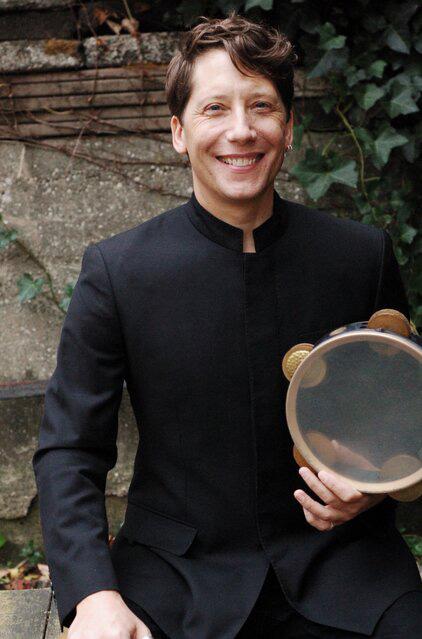
Shane Shanahan, Percussion
Percussionist, composer, and arranger Shane Shanahan has combined his studies of drumming traditions from around the world with his background in jazz, rock, and Western art music to create a unique, highly sought after style. He is one of Silkroad’s inaugural co-artistic directors, and has performed with Bobby McFerrin, James Taylor, Aretha Franklin, Philip Glass, Alison Krauss, Chaka Khan, and Deep Purple, among others, and has appeared at the White House, playing for President and First Lady Obama. He frequently hosts workshops and clinics at the world’s leading universities and museums and collaborates actively with the dance, theater, and yoga communities in the New York area, including several stints on Broadway.

Yazhi Guo, Suona, Chinese Percussion
Co-founder and founding president of the American Academy of World Music, Yazhi Guo is recognized by the industry as one of the best suona performers in the world, and is committed to integrating Chinese music with world music.

“In the wake of Hurricane Helene, Western North Carolina and the Swannanoa Valley face significant challenges as many individuals and families work to recover from the storm’s devastating impact. As we gather this evening to enjoy the power of music, we also take a moment to reflect on those who are struggling in the place I call home. We invite you to scan the QR code and join us in supporting the relief efforts aimed at providing essential aid and resources to those in need. Every contribution matters, and your generosity can help families rebuild their lives and restore hope.” —Rhiannon Giddens
1. Buncombe County Special Collections, Pack Memorial Public Library, Asheville, North Carolina.
2. United States Army. Military Railway Service, photographed by Russell, Andrew J. Two Railroad Construction Workers Hammer Track as Third Construction Worker Watches. [or 1863] Photograph. Retrieved from the Library of Congress, <www.loc.gov/item/2006676186/>.
3. United States Army. Military Railway Service, photographed by Russell, Andrew J. Military railroad operations in northern Virginia: African American laborers working on rail. [or 1863] Photograph. Retrieved from the Library of Congress, <www.loc.gov/item/2006676178/>.
4. United States Army. Military Railway Service, photographed by Russell, Andrew J. Military railroad operations in northern Virginia: men standing on railroad track. [or 1863] Photograph. Retrieved from the Library of Congress, <www.loc. gov/item/2006676176/>.
5. Convicts Leased to Harvest Timber. [Place of Publication Not Identified: Publisher Not Identified] Photograph. Retrieved from the Library of Congress, <www.loc.gov/item/2021669926/>.
6. Special Collections, J. Willard Marriott Library, The University of Utah, Japanese American Citizens League photograph collection, P1003n01_01_28.”
7. Special Collections, J. Willard Marriott Library, The University of Utah, Tsutomu “Tom” and Shirley Sugimoto Inouye digital photograph collection, p1413n04.”
Emmanuel Pahud, flute and Alessio Bax, piano
Friday, January 24, 8:00 p.m. Schwartz Center, Emerson Concert Hall
Emmanuel Pahud makes his Schwartz Center debut in this recital concert with the return of acclaimed pianist Alessio Bax for a program featuring Bach, Bacri, Franck, Mozart, and Clara Schumann.
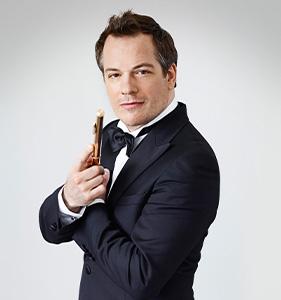




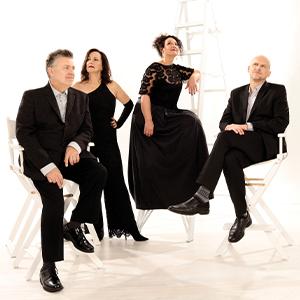

American Railroad
Silkroad Ensemble with Rhiannon Giddens
Saturday, November 16, 2024
A Festival of Nine
Lessons and Carols
December 6–7, 2024
Emmanuel Pahud, flute and Alessio Bax, piano
Friday, January 24, 2025
Emory Jazz Fest
with David Sánchez, saxophone
Friday, February 14, 2025
Emory Jazz Fest
Big Band Night
Saturday, February 15, 2025
Daniel Hope
with Polish Chamber Orchestra
Friday, February 28, 2025
New York Voices
Friday, March 21, 2025
Imani Winds and Boston Brass
Friday, April 11, 2025